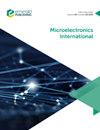Recent progress on bumpless Cu/SiO2 hybrid bonding for 3D heterogeneous integration
IF 0.8
4区 工程技术
Q4 ENGINEERING, ELECTRICAL & ELECTRONIC
引用次数: 2
Abstract
Purpose Bumpless Cu/SiO2 hybrid bonding, which this paper aims to, is a key technology of three-dimensional (3D) high-density integration to promote the integrated circuits industry’s continuous development, which achieves the stacks of chips vertically connected via through-silicon via. Surface-activated bonding (SAB) and thermal-compression bonding (TCB) are used, but both have some shortcomings. The SAB method is overdemanding in the bonding environment, and the TCB method requires a high temperature to remove copper oxide from surfaces, which increases the thermal budget and grossly damages the fine-pitch device. Design/methodology/approach In this review, methods to prevent and remove copper oxidation in the whole bonding process for a lower bonding temperature, such as wet treatment, plasma surface activation, nanotwinned copper and the metal passivation layer, are investigated. Findings The cooperative bonding method combining wet treatment and plasma activation shows outstanding technological superiority without the high cost and additional necessity of copper passivation in manufacture. Cu/SiO2 hybrid bonding has great potential to effectively enhance the integration density in future 3D packaging for artificial intelligence, the internet of things and other high-density chips. Originality/value To achieve heterogeneous bonding at a lower temperature, the SAB method, chemical treatment and the plasma-assisted bonding method (based on TCB) are used, and surface-enhanced measurements such as nanotwinned copper and the metal passivation layer are also applied to prevent surface copper oxide.三维非均相集成无凹凸铜/SiO2杂化键合研究进展
目的本文所研究的无凸块Cu/SiO2混合键合是促进集成电路行业持续发展的三维高密度集成的关键技术,它实现了芯片堆叠通过硅过孔垂直连接。表面活性结合(SAB)和热压结合(TCB)被使用,但两者都有一些缺点。SAB方法在结合环境中要求过高,而TCB方法需要高温才能从表面去除氧化铜,这增加了热预算并严重损坏了细间距器件。设计/方法/方法在这篇综述中,研究了在较低的键合温度下,在整个键合过程中防止和去除铜氧化的方法,如湿法处理、等离子体表面活化、纳米孪晶铜和金属钝化层。发现湿法处理和等离子体活化相结合的协同键合方法显示出突出的技术优势,而在制造中不需要高成本和额外的铜钝化。Cu/SiO2混合键合在未来人工智能、物联网和其他高密度芯片的3D封装中具有有效提高集成密度的巨大潜力。独创性/价值为了在较低的温度下实现异质键合,使用了SAB方法、化学处理和等离子体辅助键合方法(基于TCB),还应用了表面增强测量,如纳米孪晶铜和金属钝化层,以防止表面氧化铜。
本文章由计算机程序翻译,如有差异,请以英文原文为准。
求助全文
约1分钟内获得全文
求助全文
来源期刊

Microelectronics International
工程技术-材料科学:综合
CiteScore
1.90
自引率
9.10%
发文量
28
审稿时长
>12 weeks
期刊介绍:
Microelectronics International provides an authoritative, international and independent forum for the critical evaluation and dissemination of research and development, applications, processes and current practices relating to advanced packaging, micro-circuit engineering, interconnection, semiconductor technology and systems engineering. It represents a current, comprehensive and practical information tool. The Editor, Dr John Atkinson, welcomes contributions to the journal including technical papers, research papers, case studies and review papers for publication. Please view the Author Guidelines for further details.
Microelectronics International comprises a multi-disciplinary study of the key technologies and related issues associated with the design, manufacture, assembly and various applications of miniaturized electronic devices and advanced packages. Among the broad range of topics covered are:
• Advanced packaging
• Ceramics
• Chip attachment
• Chip on board (COB)
• Chip scale packaging
• Flexible substrates
• MEMS
• Micro-circuit technology
• Microelectronic materials
• Multichip modules (MCMs)
• Organic/polymer electronics
• Printed electronics
• Semiconductor technology
• Solid state sensors
• Thermal management
• Thick/thin film technology
• Wafer scale processing.
 求助内容:
求助内容: 应助结果提醒方式:
应助结果提醒方式:


